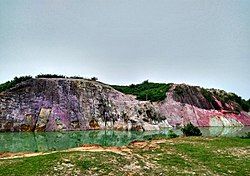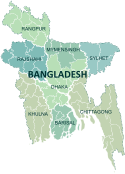Netrokona District
Netrokona
নেত্রকোণা | |
|---|---|
Clockwise from top-left: Netrokona Circuit House, house of Nirmalendu Goon, Someshwari River near Durgapur, Birishiri lake, Teligati-Atpara road | |
 Location of Netrokona District in Bangladesh | |
 Expandable map of Netrokona District | |
| Coordinates: 24°53′N 90°44′E / 24.88°N 90.73°E | |
| Country | |
| Division | Mymensingh |
| Headquarters | Netrokona |
| Government | |
| • Deputy Commissioner | Anjana Khan Majlis |
| Area | |
• Total | 2,794.28 km2 (1,078.88 sq mi) |
| Population | |
• Total | 2,324,853 |
| • Density | 830/km2 (2,200/sq mi) |
| Demonym(s) | Netrokoni, Netrokonese |
| Time zone | UTC+06:00 (BST) |
| Postal code | 2400 |
| Area code | 0951 |
| ISO 3166 code | BD-41 |
| Website | http://www.netrokona.gov.bd/ |
Netrokona (Bengali: নেত্রকোণা) is a district of the Mymensingh Division in north-east of Bangladesh.
Etymology
[edit]The headquarters of Netrokona District was located at the end of the Mogra River and was called Natorkona. Many people believe that over a period of time, Natorkona became Netrakona.[3]
Geography
[edit]Netrokona is situated in the northern part of Bangladesh, along the border with the Indian state of Meghalaya. There are five main rivers in Netrokona: Kangsha, Someshawri, Dhala, Magra, and Teorkhali. It is a part of the Surma-Meghna River System. The southeastern part of the district becomes a haor during the monsoon, while the north and west is largely alluvial plains.[4] In the north there are some foothills of the Garo Hills.
The total area of Netrokona District is 2,744.28 km2 (1,059.57 sq mi) of which 9.17 km2 (3.54 sq mi) is under forest. It lies between 24°34’ and 25°12’ north latitudes and between 90°00’ and 91°07’ east longitudes.[3]
Netrokona District is bounded by the Garo Hills in Meghalaya, India on the north, Sunamganj District on the east, Kishoreganj District on the south and Mymensingh District on the west.[3]
Netrokona Pouroshabha is a municipal town, established in 1887 and with 13.63 km2.
History
[edit]Netrokona's history is tied to the Mymensingh region. Its early history is not well-known. It likely came under the Kamrupa in the ancient period and was ruled by Koch chieftains until the arrival of Islam.[5]
Traditions in Netrokona tell of Shah Sultan Rumi who migrated to Madanpur in Atpara Upazila in 1053 CE where he preached the religion of Islam to the local people and converted the Koch king Ganesh, well before Muslim rule in the region. He is believed to have been the earliest Sufi saint to have visited Bengal. The region was eventually was captured by the Sultans of Bengal. They built several forts to control the area, such as the Ruaylbari Fort in present-day Kendua upazila, but the region was long out of direct rule. Khaliajuri in the Haor region was long ruled by a series of Hindu chieftains into the Mughal period. The region was part of the domains of Isa Khan before the Mughal conquest, when it was made part of the sarkar of Bazuha. During the Mughal period, a three-domed mosque was constructed in modern-day Atpara.[5]
In 1880, the British Raj approved the area as a mahakuma administrative region.[5] It was effective on 3 January 1882 when the region was officially named as Netrakona Mahakuma before that it was named by Kaliganj. During the British period, Shyam Biswas, a Bengali Hindu zamindar, was noted to be very cruel and abusive towards the inhabitants living in his land. He had certain regulations, such as no one passing his front yard wearing shoes or slippers. Social reformers from the village of Amati, Sonafor Uddin, Muktul Husayn Khan, Shariat Khan, Anfar Uddin, Manfar Uddin and Jafar Uddin organised people against this humiliation, rising against Biswas. Their revolution was soon followed in other parts of the district.
During the Bangladesh Liberation War, freedom fighters attacked the Atpara Thana on 19 August 1971. They murdered the Officer-in-Charge of the Thana as well as a number of Razakars, and they also looted arms and ammunition from the Thana. On 7 October, a battle was fought in Atpara, leading to the death of three more Razakars.
The Government of Bangladesh converted Netrakona Mahakuma to Netrokona District on 17 January 1984.[3]
Administration
[edit]Netrokona district is divided into ten upazilas.[6]
- Atpara Upazila
- Barhatta Upazila
- Durgapur Upazila
- Khaliajuri Upazila
- Kalmakanda Upazila
- Kendua Upazila
- Madan Upazila
- Mohanganj Upazila
- Netrokona Sadar Upazila
- Purbadhala Upazila
Demographics
[edit]| Year | Pop. | ±% p.a. |
|---|---|---|
| 1974 | 1,211,792 | — |
| 1981 | 1,442,142 | +2.52% |
| 1991 | 1,730,935 | +1.84% |
| 2001 | 1,988,188 | +1.40% |
| 2011 | 2,229,642 | +1.15% |
| 2022 | 2,324,853 | +0.38% |
| Sources:[2][3] | ||
According to the 2022 Census of Bangladesh, Netrokona District had 548,443 households and a population of 2,324,853 with an average 4.19 people per household. Among the population, 500,240 (21.51%) inhabitants were under 10 years of age. The population density was 847 people per km2. Netrokona District had a literacy rate (age 7 and over) of 66.25%, compared to the national average of 74.80%, and a sex ratio of 1040 females per 1000 males. Approximately, 15.50% (360,293) of the population lived in urban areas. The ethnic population was 21,605 (0.93%), mainly Garo and Hajong.[2]
| Religion | 1941[7]: 96–97 [a] | 1981[3] | 1991[3] | 2001[3] | 2011[3] | 2022[8] | ||||||
|---|---|---|---|---|---|---|---|---|---|---|---|---|
| Pop. | % | Pop. | % | Pop. | % | Pop. | % | Pop. | % | Pop. | % | |
| Islam |
578,501 | 70.71% | 1,245,140 | 86.34% | 1,517,751 | 87.68% | 1,762,534 | 88.65% | 2,001,732 | 89.78% | 2,103,091 | 90.46% |
| Hinduism |
219,633 | 26.85% | 174,624 | 12.11% | 189,082 | 10.92% | 204,329 | 10.28% | 207,430 | 9.30% | 202,648 | 8.72% |
| Tribal religion[b] | 18,301 | 2.24% | — | — | — | — | — | — | — | — | — | — |
| Christianity |
1,578 | 0.19% | 18,871 | 1.31% | 19,994 | 1.16% | 18,905 | 0.95% | 18,200 | 0.82% | 17,699 | 0.76% |
| Others [c] | 73 | 0.01% | 3,507 | 0.24% | 4,108 | 0.24% | 2,420 | 0.12% | 2,280 | 0.11% | 1,415 | 0.06% |
| Total Population | 818,086 | 100% | 1,442,142 | 100% | 1,730,935 | 100% | 1,988,188 | 100% | 2,229,642 | 100% | 2,324,853 | 100% |
The district of Netrakona consists of 3146 mosques, 958 temples, 183 churches and eight Buddhist temples. Hindus are most concentrated in the haor region bordering Sylhet.[3] The population of minorities has declined from 2011-2021.[2]
Bengalis are the dominant group present. The ethnic minority population is 21,605 (0.93%), of which 16,064 are Garo, 4,327 Hajong and 554 Hudi.[8]
Economy
[edit]The economy of Netrakona is largely agrarian. Susang Durgapur, an Upazila of Netrakona, is one of the major sources of the country's China-Clay used for ceramic products. Its vast water bodies (Haor) provide a wide variety of fish. Bara Bazar and Choto Bazar is commerce centre of Netrakona.
Tourist attractions
[edit]- Durgapur : The Garo hills of Durgapur is the most popular tourist attraction of Netrakona.
- Birishiri : There is a Tribal Cultural Academy. And also have a historical big pond called Sagor Dighi.
- Haor : Haor is a large area of water spaces. Biggest haor is located in Mohongonj and Khaliajuri . Dingaputa is one of the biggest haor among them.
- Madanpur Mazar (Shah Sultan Rumi): It is situated 8 km south to the Netrokona Town.
- Ranikong Mission [1]
Notable people
[edit]- Chandra Kumar De, folklorist and collector of Mymensing Gitika
- Abu Taher, 11 number Sector Commander
- Ahsan Habib- writer, cartoonist
- Akhlakul Hossain Ahmed, politician
- Bir Muktijuddah Meher Ali, politician
- Bari Siddiqui, singer-songwriter, flautist and folk musician
- Golam Samdani Koraishi, writer
- Helal Hafiz, writer and poet
- Humayun Ahmed, author, dramatist, and film director
- Jalal Uddin Talukder, former member of parliament
- Kanha, a 10th-century poet
- Khalekdad Chowdhury, reputed Bangladeshi writer, playwright and novelist
- Md. Hafizur Rahman, Minister of Food and Agriculture of Pakistan (1958–1960); Minister of Commerce of Pakistan (1960–1962); Provincial Minister of Finance and Planning of East Pakistan (1962–1965)
- Mustafa Jabbar, President of Bangladesh Association of Software and Information Services (BASIS), President of Bangladesh Computer Samity
- Mustaque Ahmed Ruhi, former member of parliament
- Nirmalendu Goon, writer, poet, painter
- Raushan Yazdani, author and folklorist
- Shahabuddin Ahmed, former President of Bangladesh
- Muhammad Zafar Iqbal, author, physicist, professor and activist. He is a professor of computer science and engineering at Shahjalal University of Science and Technology.
- Moni Singh, a Bangladeshi politician, founder of the Communist Party of East Pakistan
- Lutfozzaman Babar, former State Minister of Home Affairs
- Abu Hider, cricketer
- Ashraf Ali Khan Khasru, former State Minister of Fisheries and Livestock, former State Minister of Social Welfare
- Arif Khan Joy, former Deputy Minister of Youth And Sports
- Kumudini Hajong - Activist of Tanka movement
See also
[edit]Notes
[edit]- ^ Netrokona subdivision of erstwhile Mymensingh district, which roughly corresponds to the present district.
- ^ A category in the 1941 census for all tribals, irrespective of actual religion practiced.
- ^ Including Jainism, Buddhism, Zoroastrianism, Judaism, Ad-Dharmis, or not stated
References
[edit]- ^ Population and Housing Census 2022 - District Report: Netrokona (PDF). District Series. Dhaka: Bangladesh Bureau of Statistics. June 2024. ISBN 978-984-475-237-5.
- ^ a b c d e Population and Housing Census 2022 National Report (PDF). Vol. 1. Bangladesh Bureau of Statistics. November 2023.
- ^ a b c d e f g h i j "Bangladesh Population and Housing Census 2011 Zila Report – Netrokona" (PDF). Bangladesh Bureau of Statistics.
- ^ Masud Hasan Chowdhury and Md Mahbub Murshed (2012). "Surma-Meghna River System". In Sirajul Islam; Miah, Sajahan; Khanam, Mahfuza; Ahmed, Sabbir (eds.). Banglapedia: the National Encyclopedia of Bangladesh (Online ed.). Dhaka, Bangladesh: Banglapedia Trust, Asiatic Society of Bangladesh. ISBN 984-32-0576-6. OCLC 52727562. OL 30677644M. Retrieved 21 November 2024.
- ^ a b c নেত্রকোনা জেলা. Netrokona District. Retrieved 2019-07-19.
- ^ Sarkar, Sanjay (2012). "Netrokona District". In Sirajul Islam; Miah, Sajahan; Khanam, Mahfuza; Ahmed, Sabbir (eds.). Banglapedia: the National Encyclopedia of Bangladesh (Online ed.). Dhaka, Bangladesh: Banglapedia Trust, Asiatic Society of Bangladesh. ISBN 984-32-0576-6. OCLC 52727562. OL 30677644M. Retrieved 21 November 2024.
- ^ "Census of India, 1941 Volume VI Bengal Province" (PDF).
- ^ a b Population and Housing Census 2022 District Census Handbook: Netrokona (PDF). Vol. 1. Bangladesh Bureau of Statistics. July 2024.






